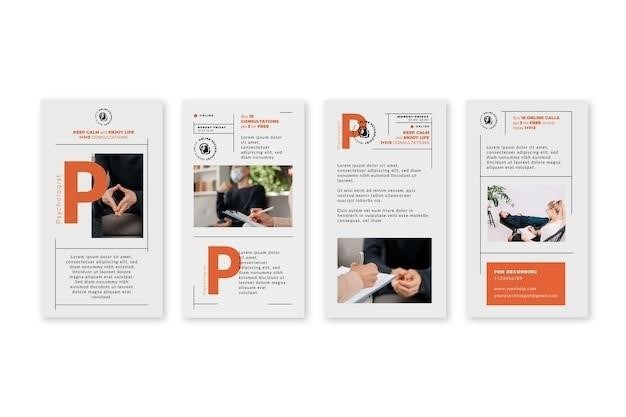The Canadian Occupational Performance Measure (COPM)
The COPM is an outcome measure designed for use by occupational therapists to assess client outcomes in the areas of self-care‚ productivity and leisure. Using the COPM‚ therapists can identify and prioritize a client’s occupational performance problems‚ track progress and measure the effectiveness of interventions.
Introduction
The Canadian Occupational Performance Measure (COPM) is a widely recognized and utilized assessment tool in occupational therapy. It serves as a client-centered‚ interview-based instrument that measures a client’s self-perceived performance and satisfaction with their daily activities. The COPM is a valuable resource for occupational therapists‚ enabling them to gain a comprehensive understanding of a client’s needs and priorities‚ fostering a collaborative approach to goal setting and intervention planning.
The COPM was initially developed in 1991 and has undergone revisions throughout the years‚ leading to the current 5th Edition Revised. This updated version incorporates advancements in occupational therapy practice and research‚ ensuring its relevance and effectiveness in contemporary settings. The COPM’s widespread acceptance and use are evident in its availability in over 35 languages‚ including Persian‚ Hebrew‚ Mandarin‚ Polish‚ and Spanish‚ making it a globally accessible tool for occupational therapists.
The COPM’s digital PDF format provides a convenient and accessible way for therapists to utilize the assessment. This format allows for easy storage‚ retrieval‚ and sharing of the measure‚ facilitating its integration into electronic health records and streamlining the assessment process. The digital format also promotes accessibility‚ enabling therapists to access the COPM from various locations and devices‚ enhancing its practicality and usability in diverse clinical settings.

Purpose of the COPM
The COPM serves as a comprehensive framework and assessment tool designed to guide occupational therapists in understanding their clients’ needs and formulating client-centered intervention plans. It is a collaborative instrument that involves active participation from both the therapist and the client‚ ensuring that the client’s perspective and priorities are at the forefront of the assessment and intervention process. The COPM aims to empower clients by providing them with a platform to articulate their concerns‚ identify their occupational performance challenges‚ and contribute meaningfully to the development of their treatment plan.
The COPM’s primary purpose is to identify and measure a client’s self-perceived change in occupational performance over time. This focus on self-perception emphasizes the subjective experience of the client‚ recognizing that their perception of their abilities and limitations significantly influences their overall well-being and engagement in daily life. By measuring these changes‚ the COPM provides valuable insights into the effectiveness of interventions and allows therapists to adapt their approach to meet the evolving needs of their clients.
The COPM also serves as a tool for goal setting and progress monitoring. The assessment process encourages clients to articulate their desired outcomes‚ creating a shared understanding of the goals they aim to achieve. Therapists can then use the COPM to track progress towards these goals‚ providing clients with a tangible measure of their achievements and fostering a sense of accomplishment.
Key Features of the COPM
The COPM stands out as a client-centered assessment tool‚ prioritizing the client’s perspective and experience. It is designed to be administered through a structured interview‚ fostering a collaborative dialogue between the therapist and client. This approach allows for a deeper understanding of the client’s unique circumstances‚ values‚ and goals‚ ensuring that the assessment process is tailored to their individual needs.
One of the defining features of the COPM is its focus on occupational performance‚ encompassing the broad categories of self-care‚ productivity‚ and leisure. This comprehensive approach acknowledges that occupational performance extends beyond the realm of work and encompasses the full spectrum of activities that individuals engage in to live meaningful and fulfilling lives. By addressing all three areas‚ the COPM provides a holistic perspective on the client’s functional abilities and challenges.
The COPM utilizes a standardized scoring system to measure both performance and satisfaction in relation to the identified occupational performance problems. This allows for objective measurement of change over time‚ providing therapists with valuable data to track progress and inform treatment decisions. The COPM’s scoring system also allows for comparison of pre- and post-intervention scores‚ providing a clear indication of the impact of therapy.
Administration of the COPM
The COPM is a structured interview-based assessment that involves a collaborative process between the therapist and the client. The interview is designed to be a conversation that allows the client to express their concerns and priorities regarding their occupational performance. It is crucial for the therapist to establish a rapport with the client‚ creating a safe and trusting environment that encourages open communication.
The administration of the COPM involves three distinct steps. Firstly‚ the interview is conducted‚ allowing the therapist to gain an understanding of the client’s occupational performance problems and priorities. This step involves exploring the client’s self-care‚ productivity‚ and leisure activities to identify areas where they are experiencing difficulties or dissatisfaction. The client is encouraged to voice their concerns‚ aspirations‚ and goals related to these areas.
Once the client has identified their occupational performance problems‚ the therapist assists in rating each problem on a 10-point scale‚ reflecting the client’s perceived performance and satisfaction. This rating process allows for a more objective assessment of the client’s experience‚ providing a quantitative measure of their level of difficulty and satisfaction.
Step 1⁚ Interview
The initial step in administering the COPM is a semi-structured interview with the client. This interview serves as a foundation for understanding the client’s occupational performance problems and priorities. The therapist’s role is to guide the conversation‚ encouraging the client to express their concerns and aspirations related to their daily activities. This collaborative approach ensures that the assessment is client-centered‚ reflecting their unique needs and experiences.
During the interview‚ the therapist utilizes a series of open-ended questions to explore the client’s occupational performance in three broad domains⁚ self-care‚ productivity‚ and leisure. These domains encompass a wide range of activities that are essential for a fulfilling and meaningful life. For example‚ self-care activities might include bathing‚ dressing‚ and eating‚ while productivity activities could involve work‚ education‚ or volunteering. Leisure activities encompass hobbies‚ social interactions‚ and recreational pursuits.
The therapist actively listens to the client’s responses‚ seeking to understand their perspectives‚ challenges‚ and desired outcomes. This empathetic approach fosters a trusting relationship‚ empowering the client to share their experiences openly and honestly. The interview serves as a crucial starting point for identifying the client’s specific occupational performance problems‚ paving the way for personalized goal setting and intervention planning.
Step 2⁚ Rating Occupational Performance
Once the client has identified their occupational performance problems‚ the next step involves rating their performance and satisfaction levels for each activity; This is achieved through a structured rating scale‚ where the client assigns scores based on their subjective experience. The COPM utilizes a 10-point scale for both performance and satisfaction‚ allowing for a nuanced assessment of the client’s perceived ability and contentment with their engagement in specific activities.
The performance rating scale ranges from 1 (severely impaired) to 10 (no difficulty)‚ reflecting the client’s perceived ability to perform the activity. This score captures the client’s perception of their physical‚ cognitive‚ and emotional capabilities in relation to the task at hand. For instance‚ a score of 3 might indicate that the client experiences significant difficulty with a particular activity‚ while a score of 8 might suggest that they are able to perform it with minimal effort.
The satisfaction rating scale also ranges from 1 (extremely dissatisfied) to 10 (extremely satisfied)‚ reflecting the client’s level of contentment with their performance in each activity. This score captures the client’s subjective experience of their occupational performance‚ encompassing factors such as self-efficacy‚ enjoyment‚ and overall fulfillment. For instance‚ a score of 2 might indicate that the client feels highly dissatisfied with their performance‚ while a score of 9 might suggest that they are very satisfied with their ability to engage in the activity.
Step 3⁚ Identifying Problem Areas
The COPM is designed to pinpoint areas where the client experiences difficulties in their daily occupations‚ leading to dissatisfaction or limitations. Once the client has rated their performance and satisfaction levels for each identified activity‚ the therapist analyzes the scores to identify potential problem areas. This involves examining the discrepancies between the client’s performance and satisfaction ratings‚ as well as identifying activities with consistently low scores across both domains.
For example‚ if a client rates their performance in preparing meals as a 7 but their satisfaction as a 3‚ this suggests a disconnect between their perceived ability and their overall contentment with the activity. The therapist can then explore with the client the reasons behind this discrepancy‚ potentially uncovering factors such as lack of enjoyment‚ physical limitations‚ or emotional distress related to cooking.
Similarly‚ if a client consistently scores their performance and satisfaction in multiple leisure activities as low‚ this might indicate a broader pattern of difficulty or dissatisfaction in this domain. The therapist can then work with the client to delve into the underlying reasons for these challenges‚ potentially exploring factors such as limited access to resources‚ social isolation‚ or lack of motivation.
COPM Application in Occupational Therapy
The COPM plays a pivotal role in the practice of occupational therapy‚ providing a framework for client-centered assessment and intervention planning. It enables therapists to gain a deep understanding of their clients’ unique experiences and perspectives on their occupational performance‚ facilitating the development of individualized treatment plans that address their specific needs and goals.
The COPM’s focus on self-perception and the client’s own definition of meaningful occupations empowers therapists to collaboratively establish priorities‚ identify areas for improvement‚ and track progress over time. This client-centered approach fosters a sense of agency and control‚ enabling individuals to actively participate in their own rehabilitation process.
Furthermore‚ the COPM’s versatility allows for its application across various settings‚ including hospitals‚ rehabilitation centers‚ community clinics‚ and private practices. Its applicability to diverse populations with varying needs‚ such as individuals with physical disabilities‚ mental health conditions‚ or chronic illnesses‚ underscores its value as a comprehensive assessment tool for occupational therapists.
Benefits of Using the COPM
The COPM offers numerous benefits for both therapists and clients‚ enhancing the effectiveness and efficiency of occupational therapy practice. Its client-centered approach fosters a collaborative relationship between the therapist and client‚ empowering individuals to take an active role in their rehabilitation journey.
The COPM’s ability to identify and prioritize occupational performance problems allows therapists to tailor treatment plans to meet specific needs. By focusing on areas that are most meaningful to the client‚ interventions are more likely to be effective and sustainable. The COPM’s scoring system provides a standardized method for tracking progress and measuring the impact of interventions‚ enabling therapists to demonstrate the value of their services and make data-driven decisions.
Furthermore‚ the COPM’s ease of administration and interpretation makes it a practical tool for therapists with varying levels of experience. The structured interview format provides a clear framework for gathering information‚ while the scoring system allows for objective assessment of change over time. The COPM’s versatility allows it to be used across a variety of settings and populations‚ making it a valuable resource for therapists working in diverse clinical contexts.
COPM Translations and Availability
Recognizing the global reach of occupational therapy‚ the COPM has been translated into over 35 languages‚ making it accessible to a diverse range of clients and therapists worldwide. This commitment to inclusivity ensures that individuals from various cultural backgrounds can benefit from the COPM’s client-centered approach to occupational performance assessment.
The availability of the COPM in multiple languages facilitates cross-cultural research and knowledge exchange‚ fostering a deeper understanding of the challenges and successes of occupational therapy practice across diverse populations. The COPM’s accessibility in multiple languages also supports the development of culturally sensitive interventions that are tailored to meet the unique needs of clients from various backgrounds.
The COPM’s widespread availability and translation efforts have made it a widely used and respected outcome measure in occupational therapy. Its global reach contributes to the advancement of the profession and the improvement of client outcomes worldwide.
COPM Resources and Further Information
For therapists seeking comprehensive information and resources on the COPM‚ the official COPM website (thecopm.ca) serves as a valuable hub. This website‚ maintained by the authors of the COPM and COPM Inc.‚ offers a wealth of information‚ including detailed descriptions of the COPM’s theoretical framework‚ administration procedures‚ scoring guidelines‚ and interpretation of results.
The website also provides access to the COPM manual and measure in various formats‚ including digital PDF and paper versions‚ ensuring flexibility for therapists in their use of the assessment tool. Additionally‚ the website offers resources for purchasing the COPM in English and French‚ as well as translations in over 35 other languages.
The COPM website further provides valuable resources for professional development‚ including training materials‚ research articles‚ and case studies. This comprehensive collection of resources empowers therapists to enhance their understanding of the COPM and its application in clinical practice‚ ultimately contributing to the delivery of effective and client-centered occupational therapy services.
The Canadian Occupational Performance Measure (COPM) stands as a widely recognized and valuable tool for occupational therapists‚ offering a client-centered approach to assessment and intervention planning. Its focus on individual occupational performance‚ coupled with its ease of administration and reliability‚ makes it a cornerstone in promoting client-driven outcomes. The availability of the COPM in various formats‚ including digital PDF and paper versions‚ enhances accessibility and flexibility for therapists.
Furthermore‚ the comprehensive resources available on the COPM website‚ including the manual‚ measure‚ translations‚ and professional development materials‚ empower therapists to effectively utilize this assessment tool in their practice. The COPM’s ability to capture a client’s subjective experience of occupational performance‚ coupled with its ability to track progress and measure the impact of interventions‚ makes it a vital instrument in shaping successful and meaningful occupational therapy outcomes.
In conclusion‚ the COPM’s user-friendly nature‚ its focus on client-centered care‚ and its robust resources position it as a powerful tool for occupational therapists seeking to enhance client well-being and promote participation in meaningful occupations.

